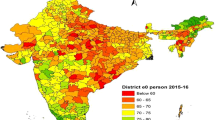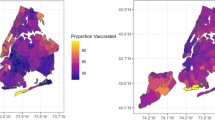Abstract
India currently has an infant mortality rate (IMR) of 73 and aims to reach 60 per 1000 live births by 2000 A.D. The “at risk” approach which has been traditionally used for Maternal and Child Health services could help to reduce costs. The main objective of the study was to identity socio-demographic “risk factors” at family level for underfive deaths and assess the validity and efficiency of a risk index scale for this purpose. A computerised database on about 71,000 individuals in 28 villages in Ballabgarh Block exists since 1987. All the underfive deaths in the study area during the period 1991–95 were compared with age and sex matched controls on socio-demographic variables. All variables which were found significant at 10% level were taken in for logistic regression. The variables found significant were used to construct a ten point scale. This scaling system was applied to all the families with an underfive child during the two year period 1996–97. Validity and efficiency of this approach was calculated. A total of 849 cases and their age and sex matched controls were studied. The variables which were significantly associated with risk of underfive deaths were: not received measles vaccine (2.19; 1.58–3.04), history of sibling death (2.03; 1.19–3.45), maternal illiteracy (1.86; 1.23–2.81), never used a contraceptive (1.59; 1.17–2.14), having more than 4 children (1.46; 1.04–2.05). About 40% of houses were labelled as high risk. The sensitivity and specificity were around 60%. The improvement in efficiency by the risk approach was 33%. Risk approach is helpful in identifying families who are at greater risk of having underfive deaths. It results in a modest increase in the efficiency of services.
Similar content being viewed by others
References
United Nations Children's Fund.The State of World's Children. Oxford and New York: Oxford University Press, 1998.
Central Bureau of Health Intelligence.Health Information of India—1992. New Delhi. Ministry of Health & Family Welfare, Government of India, 1992; 225.
Anand K, Kant S, Kumar G, Kapoor SK. Development is not essential to reduce IMR in India: Experience from Ballabgarh.J Epidemiology Community Health.
Backett EM, Davies AM, Petros-Barvazian A. The risk approach in health care with special reference to maternal and child health, including Family Planning. Public health papers 76: Geneva, World Health Organization, 1984.
Dean AG, Dean JA, Coulombier Det al. Epi Info, Version 6: A word processing, database and statistics programme for public health on IBM-compatible microcomputers. Centers for Disease Control and Prevention, Atlanta, Georgia, USA, 1995.
Norusis MJ. SPSS/PC+: SPSS for the IBM PC/XT/AT, Chicago, 1986.
Levin ML. The occurrence of lung cancer in Man.Acta Unio Int Contra Cancrum 1953; 19: 531.
Mausner JS, Kramer S.Mausner & Bahn Epidemiology— An Introductory Text. 2nd edn. Philadelphia; WB Saunders Company, 1985; 154–194.
Schlesselman JJ.Case-Control Studies-Design, Conduct, Analysis. New York, Oxford University Press, 1982; 271.
Swenson I. Relationship between pregnancy spacing, sex of infants, maternal age and birth order and neonatal and postneonatal mortality in Bangladesh.Soc Biology 1981; 28 (3–4): 299–307.
Bhurya A, Steatfield KA. Hazard logit model analysis of covariates of childhood mortality in Matlab, Bangladesh.J Biosoc Sci 1992; 24: 447–462.
Koenig MA, D'Souza S. Sex differences in childhood mortality in rural Bangladesh.Soc Sci Med 1986; 22 (1): 15–22.
Vella V, Tomkins A, Nidku J, Marshall T. Determinants of childhood mortality in South West Uganda.J Bio Soc Sci 1992; 24 (1): 103–112.
Hobcraft JN, Mcdonald JW, Rutstein SO. Socioeconomic factors in infant and child mortality: A cross-national comparison.Pop Studies 1984; 38: 93–223.
Pandey A, Choe MK, Luther NY, Sahu D, Chand J. Infant and Child mortality in India- National Family Health Survey Subject Reports, Number 11, December 1998, Indian Institute for Population Sciences, Mumbai, India.
Reddaiah VP, Kapoor SK. Risk approach in maternal care: how beneficial is this approach in reality?Indian J Pediatr 1985; 52: 61–65.
Madeley R, Latham A. Management aspects of high risk strategies in child health.Community Medicine 1979; 1: 36–39.
Author information
Authors and Affiliations
Rights and permissions
About this article
Cite this article
Kumar, G., Anand, K., Kant, S. et al. Scale for identification of “at risk” families for underfive deaths. Indian J Pediatr 67, 411–417 (2000). https://doi.org/10.1007/BF02859456
Issue Date:
DOI: https://doi.org/10.1007/BF02859456




